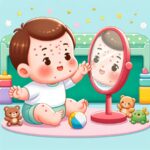Cradle Cap, a common skin condition in newborns and infants, often leaves new parents with many questions and concerns. Characterized by scaly, crusty patches on a baby’s scalp, it’s a condition that, while generally harmless, can be unsettling at first glance. This guide aims to demystify Cradle Cap, offering insights into its causes, symptoms, and how to manage it effectively, ensuring the well-being of your precious little one.
What is Cradle Cap?
Cradle Cap, medically known as infantile seborrheic dermatitis, affects the scalp of newborns and young babies. It presents as yellowish, greasy scales or crusts on the scalp. Despite its appearance, Cradle Cap is usually not painful or itchy for the baby and is not caused by poor hygiene or an allergic reaction. It’s important for parents to understand that this condition is quite common and typically clears up on its own without medical intervention.
Research indicates that Cradle Cap may be linked to overactive sebaceous glands in the baby’s skin. These glands produce an excess amount of sebum, which then combines with dead skin cells to form the characteristic crusty patches. While the exact cause is still not fully understood, a common belief among healthcare professionals is that hormones passed from the mother to the baby might play a significant role in stimulating these glands. However, Cradle Cap can also occur in babies without any clear hormonal influence. For more detailed information, visiting trusted medical resources like the National Center for Biotechnology Information can provide more depth.
How to Identify Cradle Cap Symptoms
Recognizing the symptoms of Cradle Cap is the first step towards addressing it. The most obvious sign is the presence of thick, yellow, or brown scales on the scalp. These patches might appear in isolated areas or cover a larger portion of the scalp. In some instances, Cradle Cap can also show up on other parts of the body, such as the eyebrows, eyelids, ears, or nose, where it is referred to as seborrheic dermatitis.
Although Cradle Cap is mostly seen in infants, it can occur at any age, disappearing and reappearing over time. The patches may be flaky and can come off easily, either on their own or when rubbed. Despite its harmless nature, if you notice signs of infection like redness, swelling, or if the Cradle Cap spreads beyond the scalp, it’s advisable to consult a pediatrician. Such symptoms could indicate an underlying condition that may require medical attention.
Treating and Managing Cradle Cap
For many parents, knowing how to safely treat Cradle Cap is a priority. The good news is that there are several gentle, effective methods to help manage and clear the condition. Regularly washing your baby’s scalp with a mild baby shampoo can help to loosen the scales. After shampooing, gently brushing the hair with a soft brush can also aid in removing the flakes. For stubborn Cradle Cap, applying mineral oil or petroleum jelly to the scalp for a few hours before bath time can help soften the scales, making them easier to remove during washing.
It’s important to note that while most cases of Cradle Cap can be managed at home, persistent cases may require a visit to the pediatrician. In such instances, a doctor may prescribe a medicated shampoo or cream designed specifically for infants with severe Cradle Cap. Additionally, integrating regular scalp care into your baby’s hygiene routine can prevent the recurrence of Cradle Cap. Keeping the scalp clean and moisturized is key to maintaining healthy skin for your baby.
When to Seek Professional Help
While Cradle Cap is typically a benign condition, there are situations where professional medical advice is necessary. If you observe that the Cradle Cap is accompanied by severe redness, signs of infection, or if it spreads to other parts of the body and does not improve with home treatment, it’s time to consult a pediatrician. Furthermore, if the Cradle Cap is causing discomfort or itching to your baby, this could be a sign of a more serious skin condition that warrants professional evaluation.
In conclusion, Cradle Cap is a common condition among newborns and infants that usually resolves on its own. Understanding its causes, recognizing the symptoms, and knowing how to treat it can alleviate concerns for many new parents. Remember, when in doubt, seeking advice from healthcare professionals is always the best course of action to ensure the health and well-being of your baby. To learn more about related conditions, explore our internal link library for topics such as Atopic Dermatitis, Dry Skin, and Eczema.













